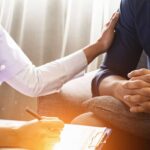AUDIT Alcohol Screen: Purpose and How It Works
16 April, 2024

The Alcohol Use Disorders Identification Test is a screening tool that helps healthcare providers assess alcohol consumption. An AUDIT alcohol screen consists of several alcohol consumption-related questions. Its purpose is to identify individuals at a high risk for Alcohol Use Disorders (AUD). Moreover, it provides valuable insights that medical professionals can use for treatments. It works by appointing scores to each answer and tallying them to evaluate the level of risk based on the guidelines.
Alcohol abuse is a prevalent issue that causes many problems in the community. Besides individual harms, excessive drinking can also compromise workplace and public safety. As such, several systems are in place to identify misuse and prevent its harmful consequences. Conducting an AUDIT screen is one way of ensuring individuals receive timely intervention. This article will present information on the AUDIT screening tool, its purpose, and how it works.
What is an AUDIT Alcohol Screening?
An AUDIT alcohol screening is an effective screening tool for identifying individuals who are at risk for developing alcohol abuse disorders. It is a multi-item questionnaire that consists of 10 questions. The scope of these questions covers multiple topics to provide a comprehensive assessment of alcohol use.
Although the test is typically done in medical settings, people can also access this questionnaire online. This can help provide peace of mind for individuals who wish to conduct the test privately. Nevertheless, consulting a healthcare provider is ideal for those whose results indicate a high risk for alcohol-associated harms.
The AUDIT is one of the most widely used alcohol screening tools. There are shorter versions of it, like the AUDIT-C test. Moreover, there are also several other types of alcohol tests. They serve as effective screens before potentially conducting tests using biological specimens like urine, blood, or saliva. They can also help inform individuals of the consequences of drinking to help them gain better control over drinking patterns.
History of AUDIT
- The AUDIT was created with the effort of six countries that conducted field studies for the test. They were Australia, Bulgaria, Kenya, Mexico, Norway, and the United States of America.
- They selected the current AUDIT questions from a 150-item set of questions.
- They administered these questions to 1888 people in primary care settings.
- The World Health Organisation published the first edition of the AUDIT in 1989 and further updated it in 1992.
- Nowadays, many healthcare providers and researchers continue to use it.
- It is available worldwide in about 40 languages, making it a useful tool for identifying risky drinking habits.

Purpose of AUDIT Alcohol Screening
The main purpose of the AUDIT alcohol screening is to identify unhealthy drinking patterns. It assesses the level of risk a person may have towards developing an AUD or if they have one. It serves as a helpful tool for medical professionals in primary healthcare or busy healthcare settings to quickly identify alcohol misuse.
Moreover, it can provide researchers with data for studies on alcohol use in different populations and help identify trends in alcohol consumption. This is particularly useful for policymakers seeking to create regulations or education programs to reduce active abuse problems in the community. This can lead to healthier alcohol consumption patterns for many individuals.
Lastly, non-health professionals can also use the AUDIT to assess their current alcohol consumption. It can inform them of their current risks and the consequences of active alcohol abuse. This can include increased risks for severe health conditions, legal repercussions from reckless behaviours while impaired, and financial strains. Overall, the AUDIT questions comprise several items that can bring benefits to people.
Components of AUDIT
The ten questions of the screening tool can be classified into three parts. The first three items ask about the actual drinking patterns of the individual. This includes the regularity and frequency of alcohol intake and the number of alcoholic beverages they tend to consume.
Meanwhile, questions four to six focus on the potential symptoms of alcohol dependence in patients. These include physical and mental withdrawal symptoms, such as increased tolerance and cravings, headaches, and nausea. The last items inquire about the effects of their drinking history on their life, such as injuries or accidents they may have experienced because of their consumption of alcohol.

How an AUDIT Alcohol Screening Works
The procedure of the AUDIT alcohol screening may take place at home or in clinical settings. In hospitals or clinics, a healthcare professional may interview the patients following the alcohol screening questionnaire. They may also hand the person a print-out and quickly explain how to answer the items.
Once completed, they will tally the AUDIT score based on the answers provided in each response category. The alcohol use screening process is quick and tends to finish in a few minutes. Each question can be scored from zero to four. After a complete tally, the administrator will interpret the score based on the guidelines.
The alcohol screening instrument categorises individuals into different risk levels based on their total score. It relies on the honesty of the participant and the accuracy of their answers. There are limitations to this screening test. Nevertheless, it is a helpful base that can help people quickly determine their alcohol risks. It also helps healthcare providers administer interventions for people.
Understanding the Results of AUDIT
An AUDIT score can range from 0 to 40, depending on the answers of the medical patient. A score of zero means the individual is not a risk for AUD. Meanwhile, scores ranging from one to seven indicate low risk. The cutoff score for risky alcohol drinking is eight and goes up to 12. Lastly, a score of 13 or higher means a high risk for AUD.
The healthcare provider may give advice or recommend treatment. They may encourage abstinence from alcohol or a lower frequency of drinking. If necessary, they may advise the patient to undergo counselling interventions to mitigate alcohol-related harms.
Conclusion
The AUDIT alcohol screen is an assessment tool that provides an accurate measure of the level of risk an individual may have for AUD. It is a test that comprises ten items to provide a comprehensive evaluation. It covers the frequency and amount of alcohol intake, symptoms of alcohol dependence, and its effects on their life. People may undergo this test in a medical setting or by looking for the test online.
The screening tool works by assigning scores corresponding to the answer of the test taker. A score below seven indicates low risks. Meanwhile, a score from eight to 12 is risky. Lastly, having a score above 13 means high risk. The purpose of the AUDIT is to help people identify their risks for AUD. It also provides medical professionals and researchers valuable insight into the current condition of the individual and the necessary treatments for them.






























